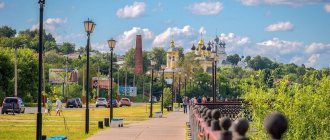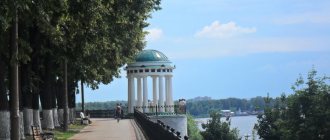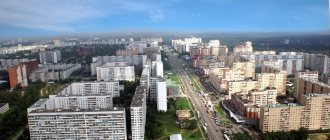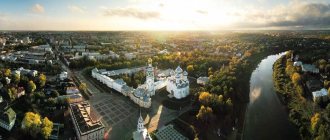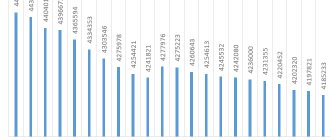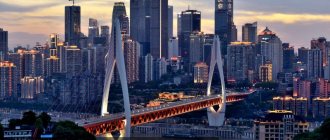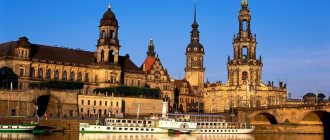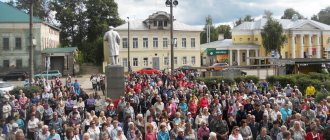The Krasnoyarsk region is the only one of the largest subjects of Russia and its geographical center. It is inhabited by approximately 3 million people. 1/5 of it is located beyond the Arctic Circle. On the territory of the region there is the great peninsula of the Russian Federation - Taimyr, and in addition, the largest Talnikovy waterfall, the high-water Yenisei river and the unique complex of unusually shaped rocks “Pillars”. In addition, gold mining is carried out in the cities and towns of the Krasnoyarsk Territory, and this is one of the main centers of this industry in the Russian Federation.
What holiday is it today?
February 10, 2022, Thursday
Today are holidays, events: Diplomat's Day Tomorrow: World Sick Day Discovery of insulin
Today is the Orthodox holiday: St. Ephraim the Syrian. Venerable Ephraim of Novotorzhsky. Venerable Ephraim of Pechersk, Bishop of Pereyaslavl. Venerable Theodosius of Totem, Spasosumorin of the monastery, leader and founder... Tomorrow: Transfer of the relics of the holy martyr Ignatius the God-Bearer. Saints Gerasim, Pitirim, Jonah, bishops of Great Perm, Ustva...
Today is a national holiday: Ephraim's Day... Tomorrow: Lawrence's Day
Seasons
Seasons, four periods of the year (spring, summer, autumn and winter) characterized by certain average temperatures. The period during which the Sun passes through one of these sectors is called the season. Spring in the Northern Hemisphere and autumn in the Southern Hemisphere begin when the Sun passes through the initial circle of declination and its right ascension is 0° (vernal equinox). Summer in the Northern Hemisphere and winter in the Southern Hemisphere occur when the sun's right ascension is 90° (summer solstice). Autumn in the Northern Hemisphere and spring in the Southern Hemisphere begin when the sun's right ascension is 180° (autumnal equinox). The beginning of winter in the Northern Hemisphere and summer in the Southern Hemisphere is considered to be the winter solstice, when the direct ascension of the Sun is 270°... Next: Seasons. Russian folk calendar. Monthly words...
Closed cities
The city of Zelenogorsk, Krasnoyarsk Territory, was founded in 1955. At this time, more than 62 thousand people live in it. It has the status of a closed settlement.
The electrochemical plant, which is located here, is considered an outstanding Russian enterprise, which combines industrial and production achievements with its work and has significant market density. The city has 10 secondary educational institutions, a lyceum, a gymnasium, an electromechanical technical school, a polytechnic institute, an aerospace university and a national university. This is a fairly clean town with lots of vegetation. Among the attractions there is an art museum, a gallery of military glory and a huge museum and exhibition center.
The city of Zheleznogorsk in the Krasnoyarsk Territory (pictured above) is also closed and has a population of more than 84 thousand people. There is a railway line, gymnasiums, lyceums, libraries, an exhibition center, theaters, parks and cultural centers. It is the cultural capital of the region.
Folk calendar about every day
Every day one season always replaces another and this determines a person’s way of life. In connection with this, a folk calendar was formed in which there were practically no nameless, unmarked days. Every day was special, had its own purpose. All this was determined by climate conditions and astrological phenomena.
A calendar is a system for counting periods of time. The first calendars arose a long time ago, in ancient times, because there was a need to measure time. The word calendar comes from the Latin words caleo - to proclaim and calendarium - debt book. This is due to the fact that in Ancient Rome the beginning of each month was especially proclaimed, and because it was customary to pay debts on the first day of the month. Different peoples counted time differently. Some calendars are based on the changing phases of the moon - lunar calendars; in others - the change of seasons - sunny; in others, the length of the year was coordinated with the change of seasons, and the counting of months was associated with the phases of the Moon. Such calendars are called lunisolar.
In Rus', the calendar was called a monthly calendar. Every day, the month book covered the entire year of peasant life, “describing” day by day, month after month, where each day had its own holidays or weekdays, customs and superstitions, traditions and rituals, natural signs and phenomena. The cyclical nature of the calendar is reminiscent of human life, where spring is youth, summer is heyday, autumn is the time of harvesting fruits (it’s good if there are some, otherwise you can live your life without collecting fruits), winter is the time of wisdom and peace. This cyclicality and rhythm determined the way of life of the farmer. The folk calendar was an agricultural calendar, which was reflected in the names of the months, folk signs, rituals and customs. Even the determination of the timing and duration of the seasons is associated with real climatic conditions. Hence the discrepancy between the names of the months in different areas... Next: Folk calendar...
Fishing calendar for every day
The fishing calendar should not be taken as an absolutely indisputable truth. Fish biting is greatly influenced by a whole range of natural factors, as well as the influence on the nature of man himself. You must not forget that the fish’s bite depends and is determined not only by the calendar dates and biological cycles of their life, reflected in the calendar, but also, no less, by the state of their habitat; the bite also depends on weather conditions: air and water temperatures, cloudiness, wind direction and strength, etc... Next: Fishing calendar...
Sharypovo
Sharypovo , in the Krasnoyarsk Territory, regional subordination, regional center, 414 km west of Krasnoyarsk. Located in the foothills of the Kuznetsk Alatau, on the river. Beresh (Chulym basin). Railway station on the branch from Achinsk on the Trans-Siberian Railway. Airport. Population 41.8 thousand people (1992; 6.0 thousand in 1979). On the site of the modern city there was a village (after 1760 - a village) Sh. (Sharypovskoye). At the end of the 19th century. There was a hospital, a 2-class school, a library, and a bank in the village. The city - since 1981, in 1985-88 was called Chernenko in honor of the General Secretary of the CPSU Central Committee K. U. Chernenko, a native of the Krasnoyarsk Territory. Sh. is growing in connection with the formation of the Kansk-Achinsk fuel and energy complex (KATEK). The city is built up with multi-storey buildings, individual cottages with garden plots are being built. Berezovskaya GRES-I and Berezovsky coal mine (19 km north of Sh.).
Orthodox calendar about every day
Orthodox calendar: Orthodox, Church and Christian holidays.
The church year is an alternation of weekdays and holidays. On weekdays, a person is called to work “by the sweat of his brow to earn his bread.” Holidays are given in order to feel liberation, to rise above the bustle and routine of the world, to feel involved in the highest of worlds, “where there are no illnesses, sorrows and sighs, but endless life.” Since ancient times, holiday cycles have been associated with the seasons. The pagans associated them with the worship of the forces of nature, the cult of which in the Old Testament was replaced by gratitude to the Creator for the universe. And although the connection between holidays and the seasons has not completely lost its power, since God is present in everything, in the plant and animal world, in human works, it nevertheless faded into the background, giving way to a spiritual foundation built on the Sacred Scriptures. The history of Orthodox holidays dates back to the times of the Old Testament. Each of the Orthodox holidays is dedicated to the remembrance of the most important events in the life of Jesus Christ and the Mother of God, as well as the memory of saints... Next: Orthodox calendar...
Ski tourism center
At the end of the last century, Divnogorsk was one of the first spiritual centers in the Yenisei province. Currently, more than 33 thousand people live here. There are a number of city-forming companies formed to support a large power plant. Most tourists know this town as a ski resort. The pride of local residents is the flat ice skating rink; the ice here is one of the best in Europe.
The main advantage is the “Old Skete” (the remains of a monastery) and the caves of the Biryusinsky karst area, where primitive people lived. There are also a number of museums with fascinating exhibitions. The town is one of the cleanest settlements in the Russian Federation.
Russian folk calendar for every day
The word “sign” comes from the word “notice”, i.e. observe. As a result of observing what happens around a person every day, he accumulates life experience. This knowledge was passed down from generation to generation, carefully preserved and people trusted it as a sacred book. Many signs have come to us from the depths of centuries without losing their knowledge. Each of us is free to choose: to dismiss all this as an absurd superstition or to take a closer look at the signs and take the centuries-old experience of generations more seriously. Most of us, when taking exams, ask them to scold them, boasting about some kind of good fortune or luck, spit so as not to jinx them or knock on wood, take a detour if a black cat crossed the road, are afraid of the number 13 and much more. And who among us does not have lucky things, numbers? Who has never resorted to the help of fate at least once in their life, who has not believed in secrets? It’s as if everything connected with signs is hidden somewhere deep in our subconscious. Often we remember them mechanically, unconsciously, or just as a joke. But, undoubtedly, the signs contain a lot of accurate knowledge and practical wisdom of our ancestors. They cover all the characteristic, often difficult to perceive, natural phenomena. Signs have preserved a lot of what was in old folk holidays and customs; they help predict the weather, grow crops... Next: Folk signs...
Norilsk - multinational composition
It is located in the north of the region, beyond the Arctic Circle, which makes it one of the coldest cities in the world. It got its name from the Norilka River, which flows nearby. As part of Norilsk, there is a residential entity called “Oganer” with a population of 10,000 people. The city does not have the status of a closed city, but foreign citizens, except Belarusians, cannot visit it without special permission from the authorities. This law has been in force here since 2001. Before this, foreigners could enter Norilsk freely since 1991.
Today the population consists almost of those who moved in the mid-20th century and their descendants. Indigenous people also live in Norilsk; these are descendants of prisoners amnestied in 1953. The population is also represented by indigenous Siberian peoples, of whom there are few, these are the Dolgans, Nenets, Nganasans, Entsy. There are many Ukrainians and Azerbaijanis in Norilsk. Local authorities are conducting a program to resettle northern residents to other cities of the country. Unfortunately, the number of city residents has decreased by 30,000 in recent years and is decreasing every year. There are many pensioners in the city, they make up 40% of the total number of citizens, most of them still work.
Local residents are seriously concerned about the poor urban environment. There are a lot of industrial enterprises in Norilsk that emit harmful substances into the atmosphere every day. In recent years, local authorities, together with plant management, have been trying to improve the situation, but so far there have been no significant results. Residents of the Central region, near which the bulk of industrial enterprises are located, are suffering the most.
Holiday calendar, dates and events of the year
All state and professional holidays in Russia, including significant World and International holidays, and other equally interesting holidays and events about every day.
The holiday has always kept pace with the history of mankind. Social time can be divided into three types: everyday life (weekdays), weekends and holidays. Everyday life is a series of practices repeated day after day and every day (work). Weekends are regular breaks from the rush of everyday life. It is believed that on weekends a person should restore his strength after working days. Day off, non-working day. A holiday is a day of celebration established in honor or in memory of someone or something. A day or series of days celebrated by the church in memory of a religious event or saint... Next: Calendar...
Administrative center
Krasnoyarsk is a famous city in Siberia, located on two banks of the Great Yenisei. More than 1 million people live here.
The main feature of these places is simply amazing nature: dense taiga forest, mysterious pillars, as well as a large hydroelectric power station, the very large Krasnoyarsk Sea and original architecture. And the main decoration is considered to be multiple fountains. The main city of the Krasnoyarsk Territory is considered a giant business and cultural center of Siberia, as well as the capital of the Krasnoyarsk Territory.
It is located between the rivers Kachi and Yenisei, in the very center of Russia. The Yenisei River is considered the largest transport route, for this reason the location of the metropolis on it makes it a gateway to the international market. Taking advantage of its proximity to Japan, South Korea and China, the metropolis regularly expands its foreign economic activities. It includes the village of Peschanka.
Prayer book, Orthodox prayers for every day
Prayer is the most powerful means for healing all illnesses - both physical and mental. Prayers can be laudatory or grateful, petitionary and repentant. If we have offended God, sinned, we must ask Him for forgiveness, that is, repent. Such prayers are called repentant prayers. If everything is fine with us, if we and our loved ones are healthy and prosperous, if we have a place to live, something to wear, something to eat, we must glorify and thank God for this. Such prayers are called praise or thanksgiving. If some misfortune, illness, trouble or need happens, you need to ask God for help. Such prayers are called petitionary... Next: Orthodox prayers...
Zodiac, astrological, eastern calendar. Zodiac signs
In ancient times, to establish the calendar, priests used knowledge of the positions of all the planets. Before the reform of Peter 1, the New Year was celebrated on the Day of the Autumn Equinox. On this day, according to ancient legend, the most peaceful treaty was concluded between the Great Race (ancient Slavs) and the Great Dragon (ancient Chinese) and it was approximately 7518 years ago... For the ancient Slavs, the calendar month corresponded to the lunar cycle from new moon to new moon, taking into account such Thus, the relationship of the entire annual cycle with astronomical and natural phenomena. There was no coherent calendar system. The main natural phenomena are still considered to this day to be the days of the solar equinox and solstice - the Slavic holidays Maslenitsa, Kupala, Ovsen and Kolyada. But during the time of Peter 1, all ancient Slavic calendars were abolished and a new Western European calendar from the Nativity of Christ (Julian calendar) was introduced, while the beginning of the calendar was moved to January 1. The Julian calendar (old style) did not take leap days into account and accumulated one extra day every 128 years. After the October Revolution in 1918, the Gregorian calendar (new style) was introduced in Russia, according to which an amendment of 13 days was introduced. The calendar of the ancient Slavs was based on two planets: the Sun and the Moon. And now they don’t use anything at all. The calendar has become static. There is no such thing as the calendar, it turns out, resting on some planet. Nobody even knows about it. There are just some standard numbers, there are months and holidays. The calendar is based on the Sun and Moon. Why is this so? Because these two luminaries influence the Earth. The Earth revolves around the Sun, and the Moon revolves around the Earth. And these two luminaries create the atmosphere on the planet. From here the calendar is built... Next: Astrological calendar...
Dream books online, interpretation of dreams
A dream book is nothing more than an interpreter of dreams and dreams, a translator of dreams. Since ancient times, people have been using dream books; dreams have always been given great importance, and people have often noticed the prophetic properties of some dreams. The dream book can become your faithful assistant every day and throughout your life, thanks to the dream interpreter you can always make the right decisions, the dream book will help you resist temptations in time, and will warn you against wrong steps and frivolous actions. Further…
Timashevsk
Timashevsk , a regional center in Krasnodar Krai, 73 km north of Krasnodar. Located on the Kuban-Azov lowland, on the river. Bricks. A junction of railway lines (to Krasnodar, Krymsk, Primorsko-Akhtarsk, Bataysk) and roads (Yeysk - Krasnodar, etc.). Population 47.8 thousand people (1992; 38.9 thousand in 1979). City - since 1966. Modern T. is the center of an agricultural region. Food, mainly sugar, industry. Factories: feed mill, hemp, brick, asphalt. Greenhouse plant, agricultural production association; railway transport enterprises.


